Since there are still nearly 5-weeks before the official start of summer, the accumulation of growing-degree-days (GDD) will continue to accelerate over the next several weeks. Many of our landscape insect pests will be rapidly emerging and be entering their best control windows before they potentially cause feeding symptoms. This writing contains part 1 of 2 parts of only a handful of the many late spring landscape insect pests that require monitoring. Some could more properly be called mid-spring pests, especially in southern NJ. Those included within part 1 of this blog are: Four-lined plant bug; Douglas-fir needle midge; Pine needle scale; & Elongate hemlock scale.

The late spring weeks in the landscape means full plant leaf emergence & many flowers plus increasing insect activity. (Photo Credit: Steven K. Rettke, Rutgers Coop. Ext.)
Four-Lined Plant Bug (Poecilocapsus lineatus) =(mid-spring weeks): The four-lined plant bug is a true bug with piecing-sucking mouthparts. This insect creates necrotic spots that can mimic the appearance of fungal leaf spots. While feeding, the nymph or adult insect will introduce toxic substances through their salivary ducts. Within less than a minute, the leaf tissues will turn black at the feeding location where the toxin is inserted. A few days later the feeding spots will develop a brown discoloration as the plant cells die & the leaf tissue become necrotic.
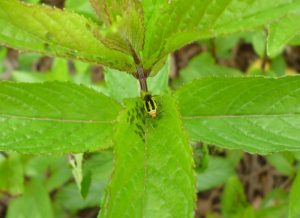
Four-lined Plant Bug adult feeds on leaf & injects a toxin with its’ piercing-sucking mouthpart. (Photo Credit: Steven K. Rettke, Rutgers Coop. Ext.)
A diagnostic curveball results when the necrotic tissue areas dry-up & crumble away to create holes in the leaves. Consequently, caterpillars, leaf miners or shot-hole fungal leaf spots can often incorrectly be determined to be the cause of the plant injuries. Typically, does not require a large population of four-lined plant bugs to cause a significant amount of injury to host plant leaves. However, for woody ornamentals, this pest rarely causes any significant plant health care concern & often only produces a curiosity.
Primary woody ornamental host plants include rose, dogwood, Azalea, Viburnum, Forsythia (e.g., sentinel plant). Other hosts also include many herbaceous plants with snapdragon, mint, mums & black-eyed-Susan being common favorites.
The four-lined plant bug has only one generation per year. It over winters as eggs inserted into one-year old woody stems. Usually, the eggs hatch sometime during May in most parts of NJ (i.e., there does not appear to be any universally accepted GDD for this pest) & active stages may extend for only three or four weeks.

Within a few days the feeding sites will become necrotic as plant cells die. Eventually these dead tissue areas dry-up & can crumble away. (Photo Credit: Steven K. Rettke, Rutgers Coop. Ext.)
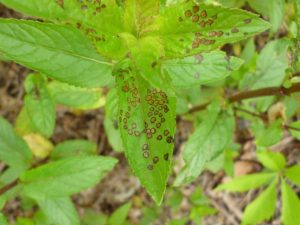
Numerous dark colored feeding spots indicates where possibly only a relatively few four-lined plant bugs have been. (Photo Credit: Steven K. Rettke, Rutgers Coop. Ext.)
Horticultural oil or insecticidal soap sprays can provide effective controls against immature nymphs. Most contact insecticides can also be effective, although since this insect primarily feeds on leaf undersides, proper coverage may be difficult. Materials having systemic or translaminar properties work best. The reduced-risk product acetamiprid is labeled for use against plant bugs.
Douglas-Fir Needle Midge (Contarinia pseudotsugae) =(~200-400 GDD = adult emergence): The estimated growing-degree-days for the adult emergence of the Douglas-fir needle midge pest is now concluding in the far southern parts of NJ & is only beginning in the far northern parts. Therefore, at this moment in time, this pest provides a good example of how valuable knowing GDD’s can be at your specific location. Even though NJ is a relatively small state, growers cannot rely on generalized NJ state recommendations for monitoring or determining best control windows for certain pests.
The Douglas-fir Needle Midge (DFNM) is host specific to only Douglas firs. The insect infests needles & symptoms create a twisted distortion having yellow banding discolorations with swollen areas. Inside the swollen areas of the needle are fly larvae (maggots) of the DFNM. Typically scouting observations for needle infestations can begin to be easily observed during mid-summer. At maturity, the swollen areas turn brown or purple. The maggot is less than 5.0 mm in size & later in the season, the larvae can be exposed by opening-up the necrotic swollen area by using a sewing needle. Symptoms can mimic those caused from Cooley spruce gall adelgids. Can also sometimes mimic the symptoms by the needlecast diseases (Swiss or Rhabdocline) if the infestation is serious enough to cause thinning from excessive needle drop.
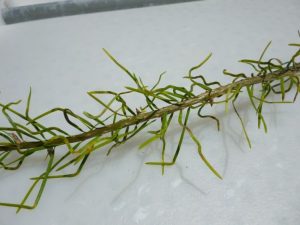
Obvious symptoms from Douglas-fir Needle Midge. The twisted, distorted needles on this branch are extreme. (Photo Credit: Steven K. Rettke, Rutgers Coop. Ext.)
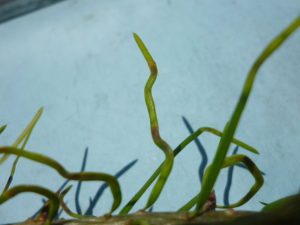
Close-up of a single Douglas-fir needle shows symptoms of at least two maggots feeding within. (Photo Credit: Steven K. Rettkie, Rutgers Coop. Ext.)
The DFNM was discovered to be an increasing problem in southern NJ more than 15 years ago. Previously the DFNM within the landscape had been completely off the radar. Infestations are limited to only Douglas-firs & had been primarily associated with Christmas tree production farms. Introduction into the landscape has unintentionally been caused by ball & burlap purchases that are initially used as indoor Christmas trees & then transplanted outdoors.
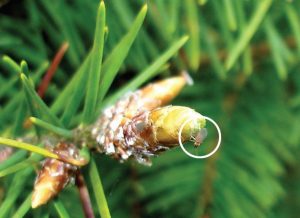
Adult Douglas-fir Needle Midge emerge from the soil after overwintering under tree. Control treatments are targeted toward adult midges as they attempt to lay eggs on growing stems. (Photo Credit: Tracey Olsen, PA Dept. of Ag.)
After dropping to the ground in November/December the larvae will overwinter in the soil under the tree they infested during the season. They pupate in early spring as the soil temperatures rise and emerge as adults in late April & continue into the weeks of May. These 1/8th size gnat-like flies can congregate in mating clouds & then begin to lay eggs in the new needle growth. The growing degree days (GDD) for adult emergence has been estimated to occur during the 200-400 GDD range. Some of the control sprays targeting adults include pyrethroids & acephate.

Hand-made trap designed to detect emergence of Douglas-fir Needle Midge. (Photo Credit: Sandy Gardosik, PA Dept. Ag.)
For most areas in NJ, the best treatment window against the DFNM will soon close or already has. Therefore, except for some of the more northern NJ counties, it has become too late in most areas for the placement of traps under trees to detect emerging adults. In most locations, traps should ideally be in place by late April if not earlier. Detection traps can be made with a plastic recycling bin or wax coated cardboard box. Cut a hole in the side of the box in order to fit a clear empty jar into the opening. Place a dry, crumpled paper towel in the jar to absorb moisture. The box should be upside-down on the ground with heavy rocks securing it in place. When Midges emerge from the ground they are attracted to light coming from the hole in the box and become trapped in the jar. Control sprays should be applied to the trees within one week of the first catch. An additional spray should be made after approximately 10 days.
Reference: Rutgers Plant & Pest Advisory, “The Douglas-fir Needle Midge” (August, 2005), by Jenny Carleo, Former Rutgers Ag. Agent of Cape May Co.
Pine Needle Scale (Chionaspis pinifoliae) =(298-448 GDD = 1st generation crawlers): This armored scale insect is a common pest of pines, especially Scotch pine, mugo pine, Austrian pine, and red pine, and occasionally on white pine, Norway spruce and Colorado spruce. White elongated shaped adult female covers are 1/8 inch and found only on needles. A long egg laying/crawler emergence period occurs from late May into mid-June, with a second generation in July (1290-1917 GDD). When the pink crawlers settle, they turn in color to yellowish tan, lose their legs, and never move again.
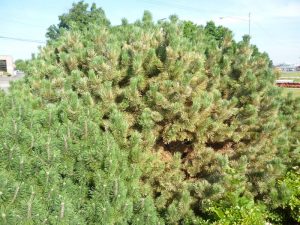
Large mugo pine showing symptoms from an infestation of Pine Needle Scales. (Photo Credit: Steven K. Rettke, Rutgers Coop. Ext.)
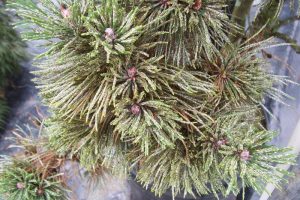
Extreme infestation with many dozens of Pine Needle Scales per individual needle. (Photo Credit: Steven K. Rettke, Rutgers Coop. Ext.)
The crawler stage and early settling periods are the ideal time to control them with insecticidal soap or 2% horticultural oil (i.e., these materials also minimize harm to beneficial insects). Research in Ohio showed that oil provided better control than did Orthene or Sevin. Control with these products will be good up until the time the crawlers begin to show some “white” or protective wax around the edges. To limit impact on beneficials, avoid broad-spectrum insecticides unless necessary.
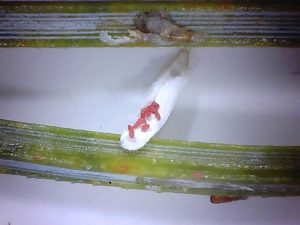
Pine Needle Scales overwinter as bright red eggs beneath wax cover of dead female. (Photo Credit: Steven K. Rettke, Rutgers Coop. Ext.)
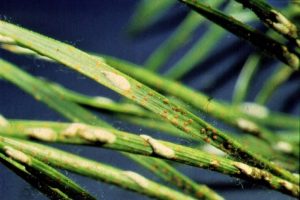
After hatching, reddish colored crawlers can move around for 48 to 72 hours before they must settle & begin to feed. (Photo Credit: Ohio State Coop. Ext.)
Elongate Hemlock Scale (Fiorinia externa) =(360-700 GDD = 1st generation crawlers): An armored scale found on the underside of hemlock foliage, and sometimes on spruce, Douglas fir and yew. Female covers are oval, flat, tan/translucent; males are whitish. There may be six or more scales per needle. Yellow spots appear on needles under light feeding and foliage appears thin; in heavy infestations, needle drop occurs, and trees may be killed. Adult females have an exceptionally long egg-laying period (lasting throughout the summer) with two overlapping generations. Crawlers (immatures) are noticeable in late May, in conjunction with new growth. Although there are only two generations per year, crawlers can emerge over an extended period. Look for the tiny crawlers using a 10-15x hand-lens.
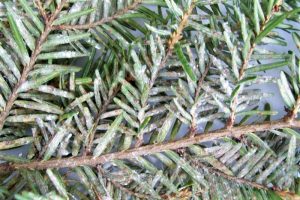
Mixture of male & female Elongate Hemlock Scale infesting hemlock needles. Males produce white, waxy filaments that sometimes can obscure females. (Photo Credit: Steven K. Rettke, Rutgers Coop. Ext.)
The Elongate hemlock scale is one of the most difficult scale species to control. They produce a puparium-like type of waxy cover, which extends under the body of the insect as well as over the top (i.e., only the sucking mouthpart creates an opening through the wax). Although oil, soap, and other insecticides are labeled, control may be mixed because all life stages are active at any one time. Pyriproxyfen (Distance) is an insect growth regulator & can provide good suppression. It is classified as a “reduced risk” material by the EPA. Dinotefuran (Safari) is a neonicotinoid that has been a product of choice to control armored scales for more than a decade. Imidacloprid (Merit) is highly effective controlling the hemlock woolly adelgid but will not provide satisfactory control of elongate hemlock scales. Acephate (Orthene) has translaminar properties within foliage & can provide some suppression.
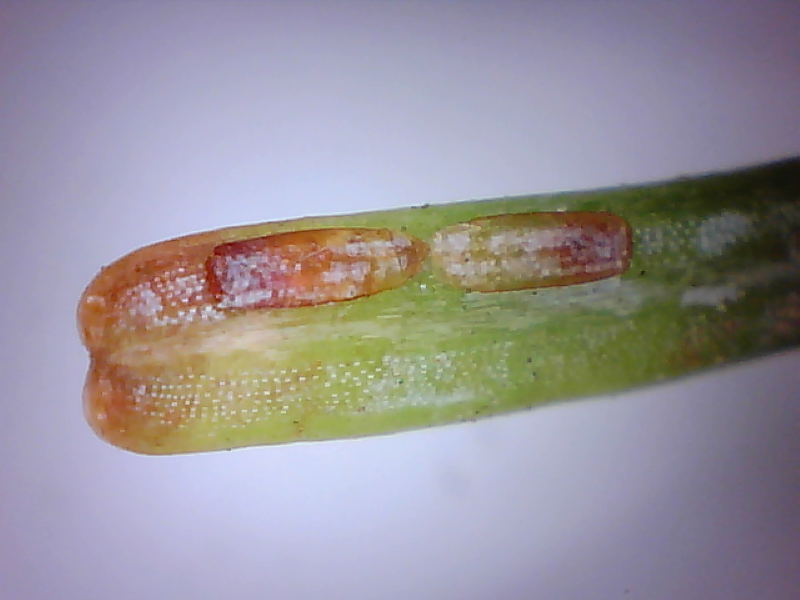
The female Elongate Hemlock Scale has a puparium-like type of waxy cover which extends both above & below the actual insect. Therefore, this is one of the most difficult scales to control. (Photo Credit: Steven K. Rettke, Rutgers Coop. Ext.)

